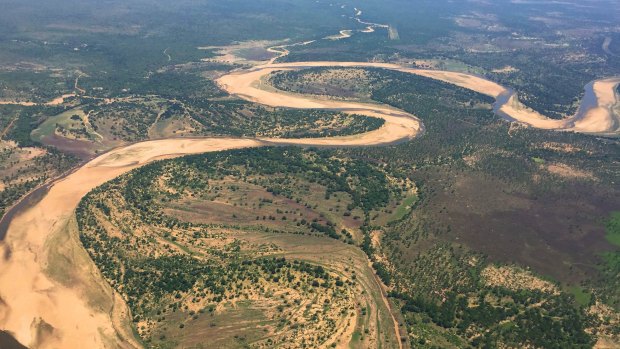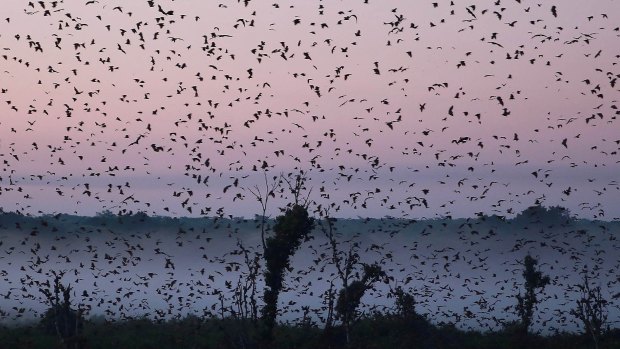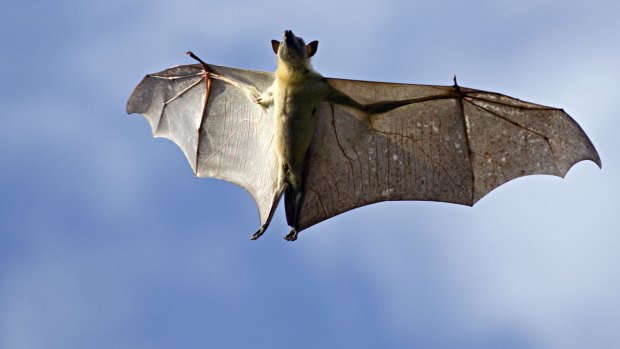This was published 7 years ago
Kansanka bat migration, Zambia tour: How to see one of nature's greatest spectacles

Flying from South Luangwa to Kasanka.Credit: Catherine Marshall
The bats are coming. They're dropping from their branches in the forests of the Congo and Equatorial Guinea. They're growing restless on their roosts in Senegal and Rwanda. They're detaching themselves from power lines and eaves in villages and towns and cities across Uganda and Tanzania, Cameroon and Burundi and the Central African Republic. They've sensed the alarm vibrating rich and clear across Africa's tropical waistband: an ancient, collective instinct kicking in. Disjointed though their colonies are, they're arising in unison from their habitats and scattering into the warm night sky.
On the ground, a far smaller migration is underway, a modest trundling of human caravans along the rutted roads of north-eastern Zambia. It's a pilgrimage aimed to coincide with the arrival of the bats at their final destination: a mushitu swamp forest inside Kasanka National Park near the border with the Democratic Republic of Congo.
It wasn't far from here that the explorer and missionary David Livingstone died, and 200 years later his entreaty resonates in the hearts of these travellers: "If you have men who will only come to visit if there is a good road, I don't want them. I want men who will come to visit even when there is no road at all."

The Kasanka National Park attracts a cacophonous gathering of up to 12 million fruit bats from late October to early January each year.Credit: Catherine Marshall
Though roads and tracks have long since been carved into this landscape, it is indeed still a wild and remote place, sparsely populated yet rich with natural phenomena. There is the rough-coated puku, the endangered, semi-aquatic sitatunga and – from late October to early January each year – a cacophonous gathering of up to 12 million fruit bats, the biggest congregation of migratory mammals in the world.
I have journeyed here myself not via those dusty, endless roads that lead from Lusaka and Lilongwe and Harare, but on a short flight from South Luangwa National Park in Zambia, where The Classic Safari Company's annual Kasanka Bat Safari begins.
There, I observed a superfluity of wildlife: giraffes and hippos, elephant and buffalo, lion greedily devouring the kill. The carmine bee-eaters had streaked their pink-and-blue bodies like brushstrokes across the sky. The African bush, baby-green with the first flush of summer, had closed thick and luscious around me.

Straw-colored fruit bat (Eidolon helvum), flying over daytime roost. Kasanka National Park, Zambia.Credit: Getty Images
But here in Kasanka – though no more than 200 kilometres away as the crow flies – something has shifted in the landscape and in the life it sustains. From above, it is an infinite, lonely, unpeopled place, a wilderness almost devoid of safari vehicles and stamped with the indissoluble patterns of nature: meandering riverbeds that appear to be both parched and moist; grasslands scabbed with rock and mouldering with damp; thickets so dense they might catch you if you fall from the sky.
It was this primordial vision that greeted the late hunter-turned-conservationist David Lloyd when he flew over it decades earlier on his way home to Lusaka from northern Zambia. The crack of poachers' guns signified the presence of wildlife, and Lloyd set about rehabilitating the depleted park with the help of a local farmer named Gary Williams. Together they established the Kasanka Trust, and in 1990 the Zambian government granted the trust permission to manage the park.
Lloyd and Williams' improvements are apparent as we make our approach: an airstrip scraped from the bush, a rudimentary gathering of rondavels beside a lake. On the ground, we find ourselves trapped inside one of those miombo woodland forests that appeared from the air to be impenetrable. The road burrows through it like an ant's tunnel; the cicadas whine in the simmering heat. My ears threaten to explode with the clamour of it all when suddenly we burst out from the forest and into the open, quenching afternoon air.
Before us lies a grassland scattered with grey termitaria so that it resembles a cemetery. Wild ginger lilies spring lush and purple from the ground. Sunbeams pick out the fine strands of the wattled crane's crown. Herds of puku graze doe-eyed and contented – undeterred by the lack of cover, my guide Jacob Shawa says, because there are no lions in this park.
"There are no predators for the puku?" I ask.
"No predators for the puku," he agrees. Then he laughs: "They don't even know how to alarm!"
The puku are safe (for now), but still danger lurks in their midst, predators fixated on a prey which, when it emerges, will be theirs for the picking. There are crocodiles waiting patiently in the black waters of the mushitu swamp. Snakes curling through the undergrowth. There is the bateleur eagle squatting on the grass, the tawny eagle perched on the road, the black kite landing portentously upon one of those tombstones. They are whiling away the last hours of daylight before the bats emerge from their forest and turn the sky to dark.
But we must stake our own claim before sunset. It's a steep climb up the ladder that's been nailed to a soaring African ebony tree, one of four such hides fringing the forest. Tucked into the tree's canopy are two platforms, each offering an exhilarating view of the bats' hideaway and the landscape sweeping away beyond it.
The sun sinks quickly, painting the sky a brilliant red. This twilight has electrified the bats, for the forest is now a clamorous, restless beast, alive with the sound of millions of creatures readying themselves for take-off. Bats drip from the trees. A branch, too heavy, crashes to the ground, delivering a feast to those crocodiles and snakes lying in wait below. Now black specks begin to emerge from the canopy: scouts, checking to see that the sun has indeed extinguished itself.
The colony follows, tentatively at first, then in a great, gushing, unstoppable flood. It is an epic plague unleashed upon this forest, a rasping, shrieking, screaming swarm that fills the sky until it is darker than night itself. Bat pups cling to their mothers' bellies as they race through the gloom. Birds of prey glide into the rabble, picking off their catch. The moon rises plump and full, a suitable backdrop to this exhilarating show.
And then, quite suddenly, it's over. The bats scatter, casting out in all directions in search of the fruit that ripens in this region every year, and for which they have made this interminable migration: waterberries and mangoes, wild loquats and sour plums. Tonight they will fly around 100 kilometres and will eat their bodyweight (around 250g) in fruit, sucking out the juice and scattering the seeds all over Kasanka so that new plants can germinate and so sustain the next generation of bats. As the year draws to a close they will leave this place, piecemeal, returning to wherever it was they came from.
It's still dark next morning when Shawa leads me to a platform high up in a waterberry tree. We're floating on a sea of swamp figs and quinine trees, mahoganies and wild date palms. Defoliated roosting branches protrude naked from the canopy. Mist sinks into the earth's clefts. Light washes the sky. Right on time, the bats appear on the horizon.
They're a mesmerising sight, the returning bats. Like some pointillist animation, they dot the sky in far-off pinpricks that transform into rash-like splotches before coalescing into thick black waves as they advance on the mushitu forest. They pause discordantly above their roost, shrieking and swooping and diving, as though teasing the rising sun. From my perch in the waterberry tree, I now see that the bats are not black at all: they are golden, and when the sun strikes their outstretched wings they appear to have been spun from silk.
FIVE OTHER UNUSUAL MIGRATIONS
SARDINES, SOUTH AFRICA
The biomass that results from the annual Sardine Run is said to rival that of the Great Rift Valley's wildebeest migration. Millions upon millions of Southern African pilchards – or, more simply, sardines – spawn in the cool winter waters off Africa's south-eastern coast between May and July. They gather into incomprehensibly vast shoals that sometimes exceed 10 kilometres in length and 30 metres in depth. It's a spectacle for human observers – and a banquet for game fish, birds, dolphins, whales and sharks.
TERNS, ANTARCTICA
It's one extreme or the other for Arctic terns, which undertake nature's longest recorded migration: a 96,000 kilometre round-trip during the northern winter from their home in the Arctic and sub-Arctic to the comparatively warmer climes of Antarctica in summer. Following spiralling wind patterns in the atmosphere, the birds avoid flying into the wind but add plenty of mileage to their already interminable journey with their zigzagging routes. The pay-off is worth it, though: these athletic creatures get to enjoy two (not-so-warm) summers each year.
ZEBRAS, BOTSWANA
Long overshadowed by the migratory exploits of the better-known wildebeest, a veritable dazzle of zebras (several thousand of the Burchill's variety) holds the record for Africa's longest land mammal migration. The 500-kilometre, two-to-three-week jaunt takes the zebras from the Chobe River, on the border between Namibia and Botswana, to Botswana's Nxai Pan National Park, where fresh grazing is plentiful in the dry season (November and December).
DRAGONFLIES, INDIA
Delicate though it is, the globe skimmer dragonfly has been known to cover up to 18,000 kilometres on its pilgrimage from India to the Maldives, the Seychelles and, finally, East Africa. This is believed to be the insect world's longest migration – even more exhaustive than that of the better-known Monarch butterfly. But as with the butterfly, there's a sad postscript to the dragonflies' story: with their short lifespan, none of them lives long enough to complete the migration, and so their journey is a relay race of sorts, undertaken for the communal good.
CRABS, CHRISTMAS ISLAND
These newborn crustaceans resemble bright red baubles as they emerge from the sea and head for the forest in carefully synchronised unison. The journey covers five kilometres and lasts up to nine days – not an insubstantial undertaking for a tiny crab. So prolific are these creatures, roads are closed to allow them to cross safely. The migration is the culmination of an intense breeding session at the beginning of the wet season (October and November) during which males and females leave the forest and meet up in the sea.
TRIP NOTES
MORE INFORMATION
GETTING THERE
South African Airways flies from Perth to Johannesburg daily with same-day connections to Lusaka, Zambia. Return airfares start at $2045 including taxes. Australian travellers can connect into Perth from major cities through SAA's codeshare partner, Virgin. See flysaa.com/au
STAYING THERE
The Classic Safari Company's seven-night Kasanka Bat Safari runs on select dates in November and December. Rates start at around $6550 per person sharing and include three nights' accommodation at Nkwali in South Luangwa National Park, three nights at Kasanka National Park, one night in Lusaka, internal flights and safari activities. See classicsafaricompany.com.au
Catherine Marshall was a guest of The Classic Safari Company and South African Airways
Sign up for the Traveller Deals newsletter
Get exclusive travel deals delivered straight to your inbox. Sign up now.